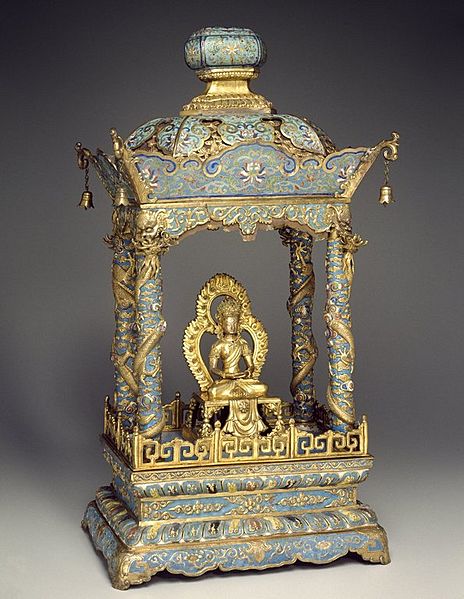Image: Shrine with an Image of a Bodhisattva

Description: Beginning in the Ming dynasty (1368–1644), Chinese artisans created many elaborate objects covered in cloisonné enamel for use in the imperial court. Cloisonné is a decorative technique of melting grains of colored glass within a gold wire framework to create a hard, colorful covering for metal objects. An amalgam of Chinese and non-Chinese traditions can be found in this lavishly decorated Buddhist shrine with an image of a bodhisattva. The gilt bronze icon appears to have been made in Tibet, probably at an earlier date than the shrine. Although the tradition of enshrining an image beneath a canopy is of Indian origin, the form of this shrine appears to have been inspired by the baldacchino in St. Peter's Basilica, Rome, created by the Italian artist Gianlorenzo Bernini (1598–1680). The Qianlong emperor was interested in foreign artistic traditions and ordered his artists to incorporate Western motifs into many of his artistic commissions. The imperial dragons around the four ornate columns, however, are Chinese, as are the cloud forms and Buddhist motifs decorating the surface. Shrine: Cloisonné enamel on copper alloy; Image: Copper with semiprecious stones, 25 1/4 x 14 3/8 x 10 5/8 in. (64.1 x 36.5 x 27 cm). Brooklyn Museum, Gift of Samuel P. Avery, Jr., 09.520a-b.
Title: Shrine with an Image of a Bodhisattva
Credit: "Brooklyn Museum"
Author: Unknown
Usage Terms: No known copyright restrictions
License: No restrictions
License Link: //commons.wikimedia.org/wiki/File:Shrine_with_an_Image_of_a_Bodhisattva.jpg
Attribution Required?: No
Image usage
The following page links to this image:

